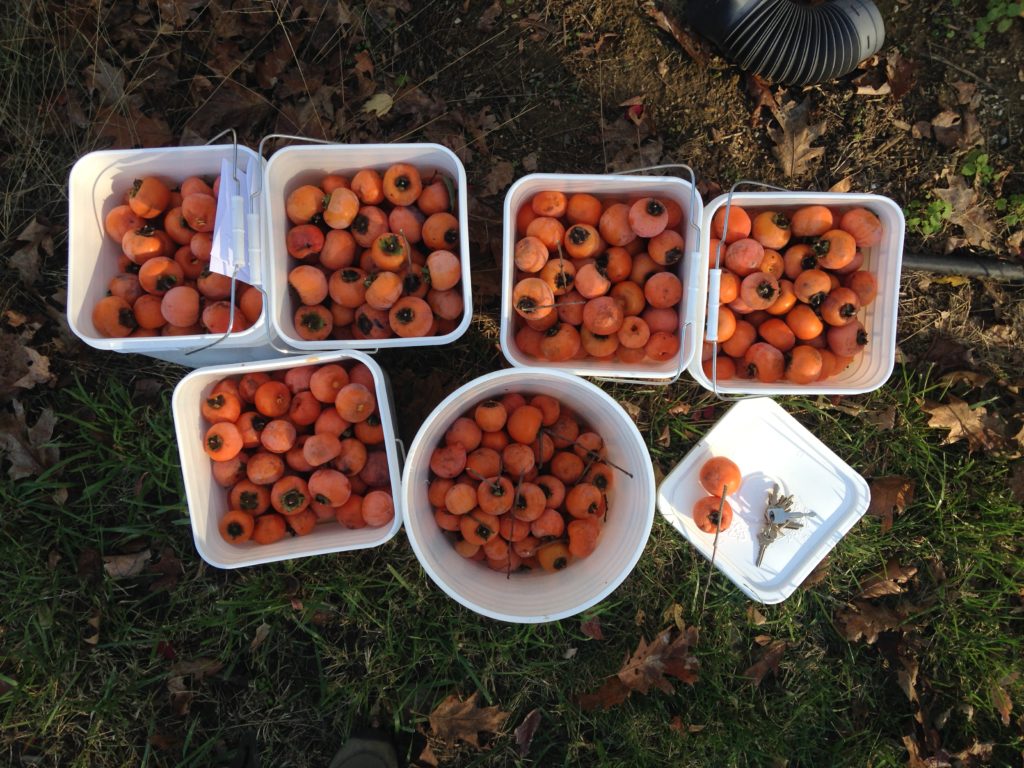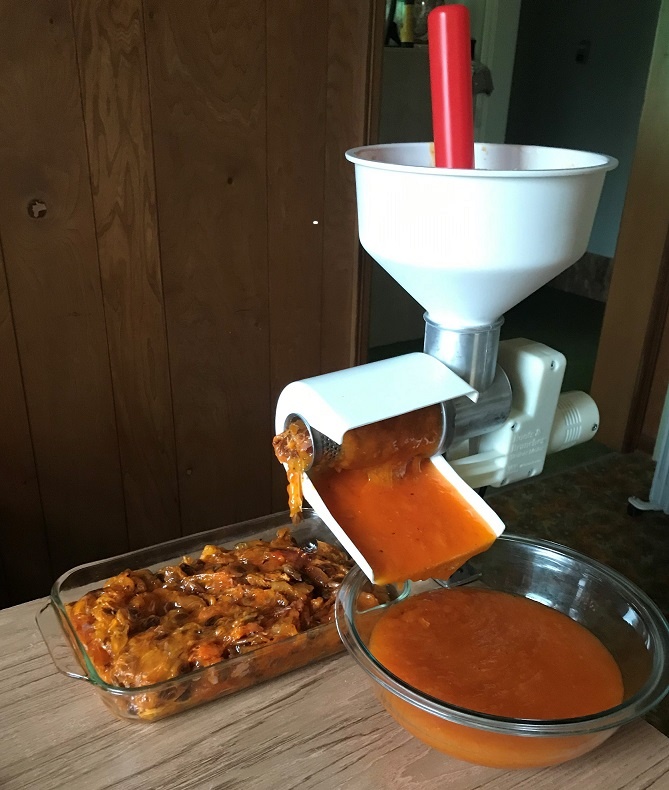Collecting and Cleaning the persimmons
The main problem with the American persimmon has always been the softness of the ripe fruit. It is easily damaged by too much depth in the collecting vessels or rough handling therefor only 5 to 6 inches of depth of fruit is placed into each container. This reduces damage to the fruit in preparation for the upcoming rinsing, disinfecting. The ripe fruit is collected from the ground as it falls. The best method is to place straw under the trees as the fruit begins to fall to lesson damage to the soft fruit. Suspended nets and tarpaulins also been used. Then as the fruit falls it is collected daily. Each day all fruit is picked up and either discarded if unacceptable by tossing to clear areas with the best fruit carefully placed into rigid containers. Egg cartons can be handy for very small quantities of larger persimmons. Small plastic buckets for medium to large quantities. The daily collection guarantees only fresh fruit to be processed. Fresh fruit will loose the fresh taste and appearance in just a few days on the ground so daily collection is by far the best procedure as it guarantees absolutely fresh fruit. The American persimmon is never picked from the tree as many such fruit will be found to be astringent (puckery). However in a pinch bumping the tree or very mild shaking will result in more fruit on the ground for collection but this is for unusual conditions 0nly, not for daily or semi-daily collection.
The persimmons should be collected with the calyx (the woody fruit top piece) removed while collecting. Collecting the fruit in containers that have holes so that the entire container can be dipped will avoid pouring the soft fruit into a strainer which can result in damage can be helpful but solid containers are ok also. Small two gallon food grade buckets are commonly used. The fruit is then dipped, completely submerged, into a disinfecting bleach water of 4 oz. of household bleach per gallon of water and swished for 30 seconds then rinsed and drained. Frequent changes of rinse water can be required if it becomes discolored. Testing the chlorine concentration with a test strip is highly recommended for large quantities of fruit. The fruit can then be stored in the refrigerator whole for a few hours or days until processed. For very large quantities and short storage a special freezer can be set to a few degrees below freezing. This will keep maximum freshness for several days while not freezing the fruit solid requiring a lengthy thawing before processing. The high sugar content will prevent actual freezing unless the temperature is below about 25F. Optionally the whole fruit can be frozen hard (to near or below zero F.) for later processing. At this stage it is no longer necessary to be careful with the fruit and it can be frozen into blocks by placing into plastic lined cardboard boxes or other containers for convenient stacking in a freezer.
Processing the Persimmons
The Victorio 250 Food Strainer
The Victorio 250 Food Strainer (Model VKP250) is a popular and very efficient way to produce persimmon pulp from fruit much more quickly than the cone strainer and pestle or food mill such as the Foley or OXO. It does require some modification to make it capable of processing whole persimm0ns due to large seed size. Typically the Victorio 250 Food Strainer with a modified grape spiral (optional add on at additional cost) and a pumpkin or salsa screen, also optional, is used. For large quantities of fruit the optional electric motor add on speeds things up considerably and is highly recommended. Producing several to many gallons of pulp becomes easy and quick with the Victorio 250 Food Strainer and motor with pumpkin screen and modified grape spiral at a total cost of about $250.
To modify the grape spiral a power sander is used to remove the far end (opposite the handle end) of the spirals to where there remains 4.0 complete spirals or less. For fruit with exceptionally large seed the spirals are removed until only 3.4 remain. While sanding the far end the central cylinder of the spiral is also sanded to reduce its diameter into a cone shape tapering to half original thickness of plastic at the far end gradually increasing to full original thickness near the modified end of the spirals. If only small seeded varieties are processed leaving 4 or very slightly more spirals might work. If the motor is used on can tell by the sound of the motor if it is near jamming. The sound will change to a high pitch when seeds are jamming. If it only makes the high pitch sound a little occasionally it will probably work ok but if it makes the strained sound more than 20% of the time it will likely eventually become jammed.
If not enough spirals are removed and the motor is in use the Victorio 250 Food Strainer can become jammed with seed and disassembly with a pipe wrench or channel locks will be required turning the spiral in the reverse direction. This tells you to remove more spirals for that particular large seeded fruit variety. As long as only 3.8 or fewer spirals remain most fruit will process well with little or no jamming.
If the spirals have been removed to accommodate large seed the pulp will not be fully recovered. running the macerated fruit that comes out with the seed can be run through the machine again to recover more of the pulp.
A Hobart/Kitchenaid Mixer Model K5-A with Colander & Sieve Set model VSM7CS or similar model with matching colander and suitable sieve have been used for larger scale processing but additional information is not available.
For very large scale a professional pulper is used but this is far beyond the budget and needs of most. They can be 4 feet long or more and weigh hundreds of pounds.

